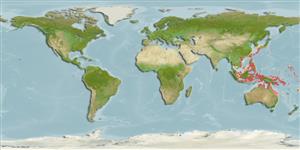>
Ovalentaria/misc (Various families in series Ovalentaria) >
Plesiopidae (Roundheads) > Plesiopinae
Etymology: Plesiops: Greek, plesios = near + Greek, ops = appearance (Ref. 45335); cephalotaenia: From the stripes on the head of the species (Ref. 27772).
Environment: milieu / climate zone / depth range / distribution range
Ökologie
seewasser riff-verbunden; tiefenbereich 0 - 12 m (Ref. 27772). Tropical
Western Pacific: Japan south to Australia; east to Solomon Is.
Size / Gewicht / Alter
Maturity: Lm ? range ? - ? cm
Max length : 7.7 cm TL Männchen/unbestimmt; (Ref. 90102)
Rückenflossenstacheln (insgesamt) : 12; Rückenflossenweichstrahlen (insgesamt) : 6 - 7; Afterflossenstacheln: 3; Afterflossenweichstrahlen: 7 - 10.
Adults occur inshore (Ref. 7300) at depths of 12 m or less in dead coral, reef flats, and on coral heads, habitats with somewhat less wave energy (Ref. 27772). Eggs are guarded by the male parent (Ref. 205).
Life cycle and mating behavior
Geschlechtsreife | Fortpflanzung | Ablaichen | Eier | Fecundity | Larven
Eggs are guarded by the male parent (Ref. 205).
Mooi, R.D., 1995. Revision, phylogeny, and discussion of biology and biogeography of the fish genus Plesiops (Perciformes: Plesiopsidae). Life Sci. Contrib. No. 159, 108 p. (Ref. 27772)
IUCN Rote Liste Status (Ref. 130435: Version 2024-2)
Bedrohung für Menschen
Harmless
Nutzung durch Menschen
Tools
Zusatzinformationen
Download XML
Internet Quellen
Estimates based on models
Preferred temperature (Ref.
123201): 26.2 - 29.3, mean 28.8 °C (based on 1571 cells).
Phylogenetic diversity index (Ref.
82804): PD
50 = 0.5000 [Uniqueness, from 0.5 = low to 2.0 = high].
Bayesian length-weight: a=0.00468 (0.00175 - 0.01251), b=3.18 (2.95 - 3.41), in cm total length, based on LWR estimates for this (Sub)family-body shape (Ref.
93245).
Trophic level (Ref.
69278): 3.4 ±0.5 se; based on size and trophs of closest relatives
Widerstandsfähigkeit (Ref.
120179): hoch, Verdopplung der Population dauert weniger als 15 Monate. (Preliminary K or Fecundity.).
Fishing Vulnerability (Ref.
59153): Low vulnerability (10 of 100).
Nutrients (Ref.
124155): Calcium = 168 [86, 287] mg/100g; Iron = 0.824 [0.475, 1.399] mg/100g; Protein = 18.5 [17.4, 19.6] %; Omega3 = 0.102 [0.056, 0.189] g/100g; Selenium = 20.1 [8.8, 43.0] μg/100g; VitaminA = 161 [51, 493] μg/100g; Zinc = 2.05 [1.32, 3.00] mg/100g (wet weight);
